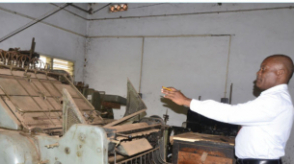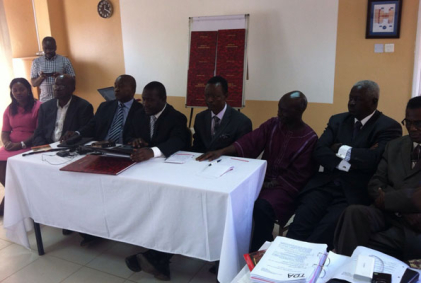The prospect of another election, against an incumbent who appears to be physically running out of time, has created a very jumpy political class, even by its own usually jumpy standards, both inside and outside of the ruling party.
The primary pre-occupation seems to be a two-headed question: who can we support now, so that we will be able to be close to whoever will come after?
The emergence of Kyadondo East MP Robert Kyagulanyi, alias Bobi Wine, over just the last three years as a new political force, has simply complicated this process quite radically, but has not altered its fundamental direction.
In his article “On rule Musevenia, Buganda and the politics of transitions,” that appeared in this newspaper on August 8, Asuman Bisiika correctly sees this situation, but then chooses to understand it in an unhelpful way.
What Mr Kyagulanyi has done is raise a lot of fear in several quarters, by simply existing in various ways. His lack of historical political baggage and record as a self-made man created independently of State patronage, has made it difficult for the ruling party to discredit him politically.
What is worse, he has stepped up the pace of his bid to become the dominant force of the Opposition, by welcoming virtually the entire body of Democratic Party (DP) parliamentarians into his newly formed National Unity Party (NUP). The reaction has been instructive.
The other side of the coin
That, however, appears to be the smaller problem. Mr Kyagulanyi is also making people nervous because he is a Muganda. And not the regime, which has always been on tenterhooks, but circles within the wider Opposition, and elements of the intelligentsia. This is very telling.
“The circumstances are clear; it is a transition period. And the projection of NUP is clear; subtly rallying the sense of Buganda nationalism. But NUP has an alibi: ……...Given the circumstances, even if NUP wanted to run a Ugandan nationalist party, it would not. What this portends is that NUP could just retreat into the most raw-sentiment political rallying point: Buganda nationalism…,” Bisiika writes.
Political activist and lawyer Hussein Kashillingi tweeted: “This NUP looks like the new Kabaka Yekka! My friends in DP, while fearing that NUP might front candidates against them, have decided to flock to Kamwokya [at the party’s headquarters].”
Also tweeting was journalist Ivan Okuda: “A few days ago, I argued that Bobi Wine’s NUP has the fundamental flaw of having its core membership seeing this as a chance at reviving Ganda nationalism. Nothing wrong with that, of course, but it has inherent limitations on terms of nation building. Today’s events vindicate me!”
Regime apologists also sought to make profit of the general sense of turmoil in Opposition ranks through the tactic of amplifying any fears about Ganda nationalism.
But in my view, this was not necessary, as suspicion of Buganda, and, therefore, of Baganda politicians, already exists in the Opposition and wider society.
This is a profound confusion born of poor politics and frankly, tribalism.
Ethnicism, tribalism and nepotism
There is ethnic nationalism, there is tribalism, and there is nepotism. These are three separate things. But republicanised Ugandans mix up those three, and call it all ‘tribalism’.
Ethnic nationalism is simply the politics of a given ethnic group aspiring for partial or total autonomy over their own affairs in accordance with their own cultural values. It is probably the most widespread form of governance, especially in the Western world. Many of the countries making up the European Union are internally subdivided on primarily ethnic lines.
Tribalism, on the other hand, is the unprincipled use of ethnic identity to advance the political and material interests of individuals. The key indicator of this is how they use and invoke ethnic nationalist arguments, but critically, do not want to recognise or give due authority to the native governance institutions created by that ethnicity. Or if they do, to then hijack them.
In all cases, it is for use as a tool to negotiate for their own personal advantages at the centre. They claim they are doing this “for their people”, but are in fact simply advancing their own personal careers, by selling the political value of their ethnicity, moreover on a retail basis. They seek to harvest individually from a collective struggle, and then betray that very struggle, once they get on the inside of the European-created government. It is an old game.
Nepotism is something else. It is basically the distribution and consolidation of public appointments and opportunities based on family and social affiliation. Basically, the goods are shared out among “relatives, in-laws and friends”.
This group naturally grows in size as the numbers of eligible members increases over the years, and soon takes over or becomes very visible in the whole realm of public appointments, government contracts and favours.
Because these are naturally primarily blood ties, nepotism often has the outward appearance of one tribe taking over. In this NRM era, it is the accusation made against people from Ankole, and Hima people in particular, as well as “westerners”, in general.
The best current example is the Uganda Peoples Congress (UPC) party. It has nine MPs in the current Parliament, all from one ethnic region, which happens to be the region of their leaders, Milton Obote and their current leader, Obote’s son, (who eventually took over the post at one point held by his mother). What is more, a good number of these people are related to one another by blood or marriage. If one were really in fear of “tribalism”, then surely, they would sound an alarm about what amounts to a large extended family project vying for State power.
The word ‘nepotism’ comes from the Italian/Latin word “nepo” (nephew). In the heyday of the Holy Roman Empire (962-1806) as a global power, with the Catholic Church as its ideological foundation and the Pope as its heads of state, many members of the clergy were not there for spiritual reasons. They were political actors. As such, they had wives and concubines, producing secret children. They would, therefore, use their offices to get “deals” for their male offspring, by presenting them as their nephews. This lives on in the Italians proverb: “A priest is a man everybody calls Father, except for his own children, who are obliged to call him ‘uncle’”.
So, the good news we have is that the NRM is actually correct: they are not a “tribalistic” regime. The bad news is that they are a nepotistic one.
But this is where nepotists are clever: they hide their “work” behind the ethnic group they come from. The standard response to complaints about this state of affairs, is to instead accuse the one complaining of being ‘sectarian’, thus using the rest of their ethnicity as a sort of human shield.
And in response, many of those in the same ‘tribe’ as the nepotists will actively defend this state of affairs. They do so partly out of the fear the nepotists have planted in them about how they will “also suffer” in the event of a regime change, and partly because they may have the hope that one day, by luck, marriage or some other development, they may also qualify for a seat at the table.
In return, they may get a few ‘bones’ thrown their way in the form of becoming the foot soldiers for the ruling clique.
But this cannot last forever. As the network naturally expands in size, it also becomes narrow in inclusion. As more and more people of a smaller eligibility are taken on board, it can move from ethnicity, to religion within the ethnicity, to strictly blood ties, and even schools attended, over time. This is where we see the ‘falling out’ incidents, where former ‘regime insiders’ suddenly find themselves on the outside with the rest of us.
There probably has never really been a truly ‘tribalistic’ government in the history of this country, because greed, by its very nature, is exclusionary; it cannot take in everybody, as then there would not be enough to over-eat. In any event, there are very few ‘tribes’ in Uganda that are small enough to be favoured wholesale by those giving out favours in any era.
It is only in this context that this anxiety over Buganda can then be understood. Nepotists use ethnic identity as a shield, but ethnic nationalists use it as an argument for greater orderly guaranteed inclusion.
Buganda is an ethnic nationalist entity, driving an ethnic nationalist movement. No more, no less, and no apology. Its principal opponent in this struggle is a nepotistic regime, falsely accusing it of tribalism.
But here are the practical problems: the default political culture in this country is the one defined by the mission school-created middle classes, a legacy of them having been centred in political leadership by the outgoing colonial governments.
The prospect of an actual native takeover of this space currently under neo-European occupation terrifies them, as it would make them subject not just to their own native laws and customs, but also to the native laws and customs of whichever other part of the country they live in.
Commentators such as Bisiika focus on Buganda because of the implications I have described. If Buganda were to undress itself of this failed European state, many Ugandans would have trouble seeing where to place themselves, since they have neglected the task of proper restoring of their own native institutions in the places they come from.
Buganda creates the biggest fear for a number of reasons, as it could up-end the very core items that make most elite and middle-class Ugandans feel like they have a country. The government of Buganda takes a very accommodative view of this, and works to make everybody feel at home.
But if one were to take this ethnic nationalism to its actual logical conclusion, then the picture would be very different.
The religious institutions would be obliged to hand back to our native religion all those sacred sites that they grabbed and desecrated by building their churches on top of them.
Yet, Africa must decolonise, reclaim and restore herself. And it is the duty of every African to help work towards this. What we call “politics” in this country, especially in the context of the 1995 Constitution, is simply the activities [colonial governor of Uganda Andrew] Cohen intended to have played in the playground he designed for the middle class. Such politics cannot resolve the two key things still keeping the African here in poverty: liberation from the Western-designed and controlled economy, and the return of all native land and other assets seized over the last 120 years.
This is an urgent matter because the collapse of Western global domination is imminent. A key development will be the evaporation of the historically-imposed value of the US Dollar.
This will mean a final collapse of these already ailing states the West planted in Africa, and therefore, a collapse also of the kind of politics generated by those states. Africans must be ready to re-organise according to their own principles and values.
Other ethnicities
Many other native communities of Uganda also want greater unified control over the territories and resources, and the right to design their own development, in accordance to the heritage of the languages and history. After all, when Uganda was a federation between 1962 and 1967, none of the federated units were complaining. But they will not stick their necks out. As a result, Buganda is portrayed as seeking “special” favours, simply because it is the only first nation prepared to speak up.
But once Buganda was able to force the NRM to fulfil at least part of its wartime commitments to restore ebyaffe, many other regions made the same demand for “their things”, despite there being no record of them having made such demands at any point since the 1967 abolition and the end of the 1981-1986 war.
Another example is the very interestingly diverse attendance of non-Baganda children brought by their parents to the annual Kisakaate education camps organised by the Nabagereka.
I am informed that in particular, one MP, who comes from far outside Buganda, made it a point of enrolling his children each year, and went on to buy a significant area of land in Buganda, but he has never been known to take to the floor of Parliament and call for the restoration of federo.
It is this kind of elite hypocrisy that enables the flourishing of the kind of perverse politics we are now seeing. What is, in fact, a wider political position, and one with a deep historical grounding and appeal, is artificially isolated to Buganda.
This is the root of all these comments that basically outline the impossible situation mainstream Baganda politicians find themselves in: they are not allowed to become Ugandans, in the sense that, if they join any Ugandan party in significant numbers, or worse still, assume leadership positions, then they are seen as trying to “take over” the organisation, and turn it into a Buganda nationalist project.
If, on the other hand, they then seek to create their own forum dedicated to the things that concern them, they are accused of being “sectarian” separatists who do not want to join the rest of Ugandans in the “nationalist” political enterprise.
But actual politics is about finding a balance between what different people want. And so responsible power structures are supposed to take on board all their views, not ask people to abandon them. And the peoples’ leaders, if responsible, are supposed to join with others and say what they actually want, and not what they think will please those in power.
Buganda’s insistence on saying what the Baganda want should be welcomed, because it simplifies things. The truth is that most people want the best for their community, and every community what is the best for its people. Ugandan “politics-of-the-centre” have meant that the general assumption is that one fights to get as much space as possible there to share out with one’s “own” people. That, actually is where “tribalism” and nepotism come from.
This brings us back to Asuman Bisiika, who goes on to say that “if there is anyone with the right credentials to be called Father of the Nation, it is Cohen. He built the national institutions on which an independent Uganda would run as a nation…(creating) Uganda Commmercial Bank or Radio Uganda, consolidated the co-operative movement in a bid to deepen African native participation in the economy.”
To conceive a colonial governor as possible “father of a nation”, shows the extent to which that “nation” is actually a European project built for the benefit of Europeans, and not an African one at all.
These “national institutions” attributed to Cohen were simply a further part of his plan to placate the Africans by making and controlling concessions. The demand for African credit, African control over the production, supply and pricing of agricultural commodities, were some of the oldest demands to be made after colonialism was put in place. And Buganda was the first place where these demands were made.
Only those wedded to the neo-colony can be appreciative of Cohen, precisely because he was sent to the colonial Uganda to solve the problem of an unmanageable African nationalism that had destabilised colonial order with rioting and boycotts in the 1940s.
Buganda has one voice: the institution of the throne (Namulondo). It is deliberate misrepresentation to ignore that voice, and instead look for its “motives” in the actions of individual politicians from Buganda. This applies not just to Buganda, but of any other native region.
Background
Buganda dilemma
Once, while hosting a radio show with [UNAIDS executive director] Winnie Byanyima, among the guests, the topic turned to the circumstances under which she gradually parted company with the NRM, a party she had helped to found.
She recounted one particularly heated meeting of (I think) the NRM parliamentary caucus. It was at a time when the party was being roiled by accusations of failure to take serious action against corrupt but important officials. There were other issues too.
The meeting became a showdown in which Ms Byanyima was left locked in a bruising one-on-one exchange with the President, which was making him increasingly angry. The matter was commented on quite a bit in the media at the time.
What Ms Byanyima revealed was a new detail: that what she found frustrating was that nobody else was speaking up. Instead, throughout the exchange, she kept being slipped notes written by her fellow caucus members urging her to raise various other points that clearly, they were not prepared to be seen raising themselves.
She said this was having the effect of making it appear that she was the only unhappy person in the caucus, thus allowing the President to be dismissive of this “minority” view, and portray her as a self-promoter.
This is the Buganda dilemma.




































 The symbol of the International Criminal Court at the Hague in the European country of The Netherlands.
The symbol of the International Criminal Court at the Hague in the European country of The Netherlands.















